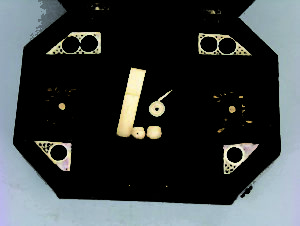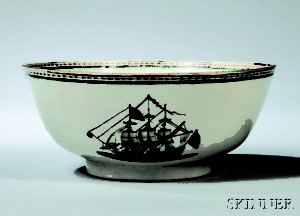 By Anne Gilbert
By Anne Gilbert As any antiques collector will tell you there is nothing new about America trading with China. Even though the Dutch East India Company began China trade around 1609, it wasn’t till 1784, when the Empress of China sailed from New York with a load of ginseng that launched trade. After a 16 months voyage they returned with boxes of china, textiles, tea and hundreds of other objects. By the mid-18th century they were decorating American homes.
One interesting historical fact is that sunken, China Trade ships are still being discovered. More amazing, quantities of Chinese porcelain had survived.
The boxes, cases and canisters that contained everything were fortunately appreciated for their beauty and have survived to become valuable collectibles. Ginger was shipped in beautiful lacquer boxes. Large tea caddies of pewter were often shipped inside the lacquer boxes. It was the custom for ladies to mix blends of tea from one or more of these decorative containers.
 Few of the fragile textiles have survived. Aprons, robes and bedspreads occasionally turn up. Chinese embroidered silks were framed and used as fire screens in the mid 19th century.
Few of the fragile textiles have survived. Aprons, robes and bedspreads occasionally turn up. Chinese embroidered silks were framed and used as fire screens in the mid 19th century. Small pieces of lacquer furniture were being imported during the late 19th century. Nested step tables were considered fashionable for serving tea. When they were custom-made, the buyers’ initials were decorated with gilt letters. They still turn up at auctions and estate sales. If the lacquer is cracked or missing, prices are low.
Early pieces of China trade china were often commissioned with specific designs and family names. Well documented are the Masonic m otif pieces ordered by George Washington and others.
CLUES: Only recently has Chinese export silver become interesting to collectors or appreciated. Most likely because it hasn’t been recognized. The same could be said for Chinese silver bangle bracelets that sell for low auction prices if they sell at all. Flatware was copied from European and English designs. The shell was the most popular motif. Usually they were marked with a pseudo London hallmark. Other pieces have Chinese hallmarks. Their purity was 880 parts per thousand or more.
 Since antiques travel you may get lucky and discover a piece of China trade history.
Since antiques travel you may get lucky and discover a piece of China trade history.














Follow Us